Canadian Aquaculture R&D Review 2007
Miscellaneous
Interprovincial Partnership to foster sustainable freshwater aquaculture

Experimental sites : LARSA laboratory - Ferme piscicole des Bobines - Pisciculture Marinard.
The Interprovincial Partnership for Sustainable Freshwater Aquaculture Development, formerly known as the Interprovincial Initiative for Sustainable Freshwater Aquaculture Development, has the mission to promote the sustainable development of freshwater aquaculture in Canada. It proposed an innovative approach by establishing R&D partnerships with Canadian experts in order carry out specific projects related to the issues voiced by the industry stakeholders. The objectives of this organization are then to:
- Create a concerted consensus on industry priorities
- Identify projects with R&D or pre-commercial development potential and gathering research and/or technology transfer expertise required to accomplish these projects
- Promote the creation of synergies between all groups involved, and thus, avoid duplicating R&D efforts and encouraging an optimal utilization of the resources.
- Search and channel research funding towards projects that originate directly from priorities established by the industry
The Partnership is mainly composed of a representative from each provincial or regional freshwater aquaculture association.
Feed Trials in Canada
In 2004-2005, the first of a series of projects under the name "Feed Trials in Canada" was carried out to compare the performance of salmonids fed with Danish feed against the performance of salmonids fed with commercial feed available in Canada.
The Danish trout feed industry has been regulated as to the composition of the grower feeds that are allowed to be used by the farmers. Their feed composition regulations relate to the maximum amount of phosphorus and nitrogen and ash, minimal level of energy and digestibility, and maximum feed conversion ratios permitted.
The Canadian study allowed researchers to test the practice of using "high energy" feed on a small scale under a laboratory controlled environment (brook trout of 60-200 g and rainbow trout of 400-1000 g) and on a large scale under normal commercial conditions (rainbow trout 200-500 g, brook trout and arctic charr of 60-200 g). The studies showed that the use of high performance feed, Danish feed or similar, complying with strict environmental regulations helped improving the growth performances (FCR, SGR) as well as environmental performances (reduction of phosphorus discharge in effluent). A greater accessibility to high performing feed will allow Canadian growers to achieve their environmental targets while keeping production costs competitive.
Research team: Grant Vandenberg, Éric Boucher, Richard Moccia, Pierre Dubé, Robert Vaillancourt, Sylvain Lareau, Karen Tracy, Guy Ouellet, Normand Roy, Yves Boulanger, François Roberge, Francis Dupuis and Jean Maheu. For information contact: Charley Cyr (Email: CyrCh@dfo-mpo.gc.ca) or Doug Geilling (Email: geilingd@dfo-mpo.gc.ca). Submitted by DFO (ACRDP).
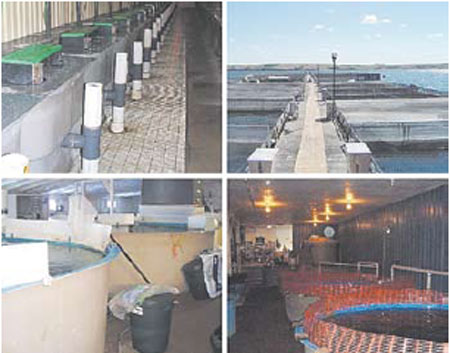
Tests were conducted at an Alberta commercial recirculating farm, a Saskatchewan commercial cage system, and the Alma Aquaculture Research Station.
Subsequent Trials
In 2006, a second series of feed trials followed the first one. This time, the study was extended to include different systems and larger size fish and was carried out exclusively on rainbow trout. The performance of the Danish feed was assessed and compared to the performance of the currently used feeds in two Alberta commercial recirculating farms (trout of 60-200 g), on a Saskatchewan commercial cage system (trout of 650- 1000 g) and in a lab-scaled controlled environment at the Alma Aquaculture Research Station (trout of 750-1500 g). The results of this study are showing similar trends to those in the previously carried out feed trials where Danish feed helped improve the growth performances (FCR, SGR) as well as environmental performances (reduction of phosphorus discharge in effluent). On the other hand, the development of new formulations from Canadian feed manufacturers tends to reduce the gap between the performances of Danish feed and the performances of the traditional Canadian feed.
Research team: Grant Vandenberg, Éric Boucher and Richard Moccia, Lorne Louden. Dean Foss, and Max Ménard. For information contact Doug Geilling (Email: geilingd@dfo-mpo.gc.ca). Submitted by DFO(ACRDP).

Experimental work was done at Pisciculture Mont-Tremblant, Laboratoire LARSA, and Pisciculture des Alléhanys.
Another project (2006) to study the commercial, environmental and physiological performances of Brook trout fed with low phosphorus/high energy, newly formulated Canadian feed permitted researchers to investigate the effect of fishmeal replacement and fat content in commercial feed on brook trout performance. The lab study at LARSA was carried out to examine the effects of the experimental feed on growth performances, on the liver functions (cellular and physiological levels), on the body composition and on phosphorus waste. Subsequently, field trials were to be conducted on commercial farms to validate the differences in performance, body composition and phosphorus output. The results that will emerge from this study will allow a better understanding of the relationship between brook trout performance and fat content in feed. This may lead to development of new feeds which could be very important in the Quebec context taking into account the importance of the species and the environmental regulations associated with nutrient releases in receiving waters.
Research team: Grant Vandenberg, Éric Boucher, Keith Were, Pierre Dubé, Yves Boulanger and François Roberge. For information contact Charley Cyr (Email: CyrCh@dfo-mpo.gc.ca). Submitted by DFO (ACRDP).
Testing aquaponics in Alberta
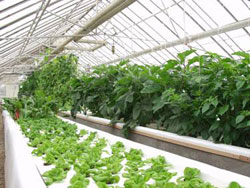
Aquaponics operation in Brooks, Alberta Agriculture, Production Greenhouse. The facility was build in 2002 using model of University of Virgin Islands developed by Dr. James Rakocy.
Aquaponics facilities contain plant and fish components together in one re-circulation system. Water leaving the fish tanks, rich in nutrients, is used for plant growth, while the plants are used as biofilters to reduce the build-up of nitrogenous and mineral wastes in water returned to the fish tanks. An extensive study during first year of operation demonstrated the technical feasibility of aquaponics technology under Alberta growing conditions.
The project focused on high value crops for economic analysis of aquaponics operations in Canada. The data on yields of both fish and greenhouse crop components has been collected during 2005/06. A hatchery has been added to the facility in Brooks to optimize aquaponics operation.
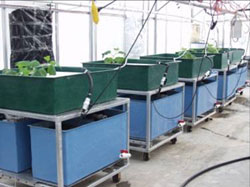
Aquaponics mini-systems constructed to increase the experimental aquaponics capacity in Alberta. The mini-systems were used in studies to develop control strategies to maintain high crop yields without introducing contaminants into the fish produced. The project was also funded by University and Alberta and NSERC Canada.
Economic analysis has been conducted by the Economics and Competitiveness Sector of AAFRD. The analysis showed that as much as 70% of gross revenue may come from the greenhouse portion in aquaponics operations. The aquaponics minisystems have been built for the project and has been in operation for one year confirming that the same principles can be applied in a much smaller scale. These trials produced the highest crop yields reported in the literature for soilless culture without use of mineral fertilizers.
Research team: Nick Savidov, Eric Hutchings, Nabi Chaudhary. For information contact Nick Savidov (Email: nick.savidov@gov.ab.ca). Submitted by Alberta Agriculture Food and Rural Development and DFO(ACRDP).
Apr. '06-Mar. '08
Quebec forms aquaculture strategic knowledge node
The Réseau Aquaculture Québec (RAQ) is a network of researchers (academic, provincial and federal government researchers, CEGEP professors) involved in aquaculture research in Québec. RAQ researchers are involved in the three research activity areas targeted by AquaNet, i.e., enabling communities, healthy ecosystems, and creative product. While our principal strength is at the ecosystem level, we have also integrated humanities and social sciences into our research program from the beginning of our activities and are now working to develop some expertise in marine biotechnology.
RAQ's general goal is to work on the development of an economically and environmentally sustainable aquaculture sector in Québec. Specific objectives with respect to an AquaNet geographic knowledge node are: 1) to promote networking of Québec researchers and industry with Canadian industry and AquaNet researchers from other geographic sectors; 2) to promote AquaNet activities towards our local partners; 3) to participate in building international partnerships (e.g., Marine Genomics, France-Canada network on larval production; 4) to participate and promote training of HQP; 5) to promote sharing of technical and human resources; 6) to help our researchers to be successful in getting aquaculture research funds at the provincial and federal levels; and 7) to work on information dissemination to the industry, government, and the public.
For more information contact Céline Audet (Email:Celine_Audet@uqar.qc.ca). Submitted by AquaNet.
New DFO lab to enhance disease investigation
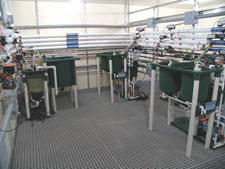
The new state-of-the-art Charlottetown Aquatic Animal Pathogen and Biocontainment Laboratory will enable research into virtually any aquatic animal-disease or pathogen.
The Charlottetown Aquatic Animal Pathogen and Biocontainment Laboratory (CAAPBL) is an important constituent of the DFO Aquatic Animal Health Reference laboratory network. CAAPBL is located within a Canadian Food Inspection Agency (CFIA) laboratory and administrative facility in Charlottetown, PEI. Live aquatic animal holding capacity has been retro-fitted within former large animal Containment Level 3 areas. Thus, CAAPBL provides a state of the art biocontainment facility that enables DFO to support virtually any aquatic animal-disease/pathogen investigation. It is the only facility in North America that has the structural components CAAPBL provides or the stringency of waste treatment in support of aquatic animal biocontainment. CAAPBL activity will focus on research in support of the National Aquatic Animal Health Program, i.e., research on aquatic animal-disease interactions (health/disease/pathogenspecific), diagnostic tools development and emergent disease and epizootic investigations. Besides live animal holding capacity there is also available molecular-based (in vitro) testing, veterinary support (diagnostics, post mortem, animal care), and expertise in quality assurance and ISO/IEC compliance.
Research team members: Phil Byrne, Gilles Olivier. For information contact Phil Byrne (Email: byrne@dfo-mpo.gc.ca). Submitted by DFO (ACRDP).
Mobilizing Aquaculture Knowledge: AquaPort.ca as Semantic Web
As a new Canadian industry, aquaculture has a high knowledge demand as it strives to become more competitive and sustainable. Embracing industry, academia, government and communities, the aquaculture sector in Canada will increasingly depend upon knowledge exchange that is mediated by the web. Without such a vehicle, opportunities for innovation and research will be lost and the ability to engage society in learning about aquaculture will be limited.
Aquaport.ca, the web portal for Canadian aquaculture, will effectively bridge the gaps by delivering "just-in-time" knowledge resources. It will adapt content to users' needs and ensure its "findability." It will provide a one-stop gateway to an array of knowledge resources such as scientific, industry and government publications, workshop and conference proceedings, research-in-progress information, fact sheets, online seminars and forums, directories of expertise and services, and news feeds. It will be built upon a robust database anchoring a dynamic web-based user interface. Designed to be open and publicly accessible, it will be based on the "build once - deploy for many uses" principle, and be scalable to grow with the Canadian aquaculture community.
At least 10 students from across the country will be involved to help build the content and solve knowledge transfer problems. AquaPort.ca is a collaborative effort between the Research team and the Canadian aquaculture community, embracing industry, government and academic partners and supporters. Among the collaborators so far are the British Columbia Aquaculture Research & Development Committee, the Canadian Aquaculture Industry Alliance, the Aquaculture Association of Canada, le Société de développement de l'industrie maricole, le Réseau Aquaculture Québec and the DFO Aquaculture Collaborative Research and Development Program. The Institute for Coastal Research at Malaspina is the project's institutional lead.
Research team: Bill Pennell, Tim DeJager, Céline Audet, Duane Barker, Thierry Chopin, Cyr Couturier, Rich Moccia, Jeremy Rayner, Rick Rollins, Barbara Thomas, Joy Wade, Carmen Léger. For more information contact Tim DeJager (Email: dejagert@mala.bc.ca; Website: www.aquaport.ca). Submitted by AquaNet.
Jul. '06 - Jun. '07
Understanding the opportunity and cost of organic aquaculture production
The goal of this project is to assess the costs and benefits of organic aquaculture for Canadian consumers, retailers, producers and the general public. The project will assess i) the Canadian and international demand for organic aquaculture products, ii) gaps between Canadian conventional aquaculture practices and prevailing organic product standards in Canadian and export markets, and iii) the basis for selected key organic aquaculture requirements for use in discussions of organic standards with stakeholders. It will further gauge stakeholders' willingness to utilize scientific evidence to assist in the evolution of organic aquaculture standards in Canada.
The project started in March 2005. It will lead to the development of draft standards for organic aquaculture production in Canada, as input for negotiations between stakeholders.
Research team: Keith Culver, Norman Siebrasse, Karen Finlay, David Castle. For information contact Keith Culver (Email: kculver@unb.ca). Submitted by AquaNet.
Mar. '05-Jul '06
Evaluating site use in coastal areas
This project examines the problem of defining the value of marine areas based on characteristics of the marine site, as well as the cumulative ecosystems effects from alternative strategies for marine use, including the development of aquaculture sites. The research is directed at providing tools for supporting federal and provincial governments, as well as commercial, environmental and community groups regarding decisions on the effective use of marine sites. The procedure presents a problem-solving framework based on:
- a spatial analysis of the marine site's key ecosystem characteristics;
- a methodology for the evaluation of ecosystem effects from marine use;
- direct feedback from multiple decision makers participating in the marine governance process;
- the formulation of a multicriteria decision making problem for ranking aquaculture site evaluations; and
- an analysis of alternative marine site use and rankings by the various participants.
Tools have been developed including a spatial information interface that facilitates the estimation of cumulative effects by considering the impact of each site's overlapping ecosystem components. There is also a decision-support tool designed to reconcile the different and often conflicting perspectives associated with various marine-use strategy alternatives.
Research team: Dan Lane, Wojtek Michalowski, Rob Stephenson, Fred Page, Michael Sutherland, Yanlai Zhao, Ibrahim Ozer. For information contact Dan Lane (Email: dlane@uOttawa.ca; Website: http://aqua.management.uottawa.ca/). Submitted by AquaNet.
Jan. '05-ongoing
Culture trials with brown algae in Chaleur Bay
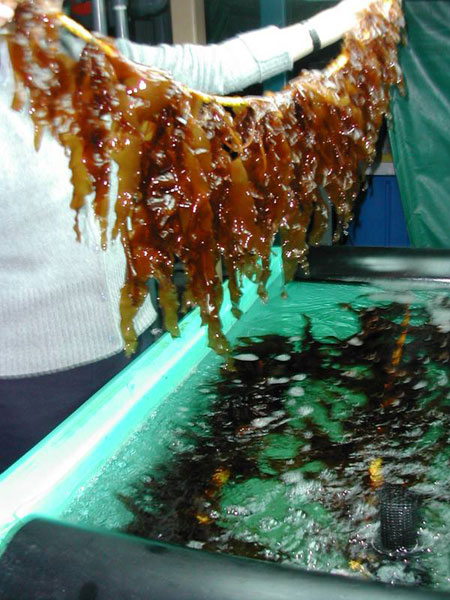
Blade kelp was cultured at the Maurice Lamontagne Institute near Mont Joli, Quebec.
There is growing interest in Quebec in the development of nutraceutical, cosmeceutical and horticultural fertilizer products based on marine algae. The production of algal biomass from culture has been suggested as a method of more effectively controlling the supply and quality of algae. Blade kelp (Laminaria longicruris) was cultured in a controlled environment at the Maurice Lamontagne Institute (MLI) in the fall of 2005 from spores obtained from fertile fronds harvested in Paspebiac Bay. In May 2006, the cultivated algae were transferred to the sea off Paspebiac.
The initial aim of the project was to monitor the seasonal growth of the algae until December 2006 and to compare cultivated and wild algae in terms of their respective components of commercial interest. Transfer to the sea was successful and the plants showed good growth until the middle of the summer. However, the algae were lost due to colonization by a bryozoan (Membanipora membranacea, invasive species) around late July, thus putting an end to the culture around late September. An analysis of the causes and consequences of this colonization will be added to the project. In addition, during the fall of 2006, the preculture experiment conducted in 2005 will be repeated, with seeding densities controlled to accelerate growth.
Research team: Louise Gendron, Gilles Savard. For information contact Louise Gendron (Email : gendronl@dfo-mpo.gc.ca). Submitted by DFO(ACRDP).
Apr.'06-Mar.'07
Holistic health management in aquatic ecosystems
Our group comprises 7 investigators from 4 Universities in Atlantic Canada. The project establishes a geographically-rooted Strategic Knowledge Node, serving as a partnership between researchers and the aquaculture industry, to develop and advance the applied science(s) pertaining to healthy ecosystems, disease management, and the environmental footprint of Canadian aquaculture practices. The core contention of this node is that optimal health management should aim at: 1) minimizing the impact of diseases in aquaculture systems and aquatic ecosystems, and 2) optimizing reciprocal influences between ecosystems and aquatic animal farming. More specific objectives are to: Establish a strategic research community in the understanding and prediction of aquatic ecosystem health; Establish a multidisciplinary think-tank to initiate transdisciplinary synergies and provide guidance on new approaches to aquatic ecosystem health; Support innovative research initiatives promoting scientifically sound, environmentally responsible and ecologically sustainable aquaculture; Enhance research collaboration and networking in the area of ecosystem health, at regional, national, and international levels; Enable leveraging of additional funding to support fish health and ecosystem health research projects; Encourage effective transfer of knowledge to stakeholders with particular attention to private sector and highly qualified personnel.
Research team: Franck C.J. Berthe (UPEI), Omer Chouinard (U. Moncton), Larry Hammell (UPEI), Bruce G. Hatcher (U.C. Cape Breton), Michael Van Den Heuvel (UPEI), Karen Kidd (UNB), Matt Litvak (UNB), and David Speare (UPEI). For information contact Franck Berthe (Email: fberthe@upei.ca). Submitted by AquaNet.
Jun. '06-Jul '07
Aquaculture by-products the focus of research at Newfoundland's Marine Institute
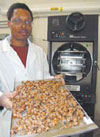
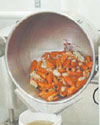
Each year the aquaculture industry in Atlantic Canada produces significant quantities of processing discards. More stringent environmental regulations and increasing waste management costs are placing pressure on industry to identify alternative uses for waste streams. To assist industry in capitalizing on the tremendous potential for product development diversification and value addition, the Fisheries and Marine Institute of Memorial University of Newfoundland opened the Atlantic Canada Fishery By-Products Research Centre in the fall of 2006. The centers' purpose is to use innovative research and development to encourage complete utilization of fish and shellfish, yielding significant benefits for the Atlantic Canadian region.

The Atlantic Canada Fishery By-Products Research Centre is developing new products and uses from fish and shellfish processing "waste".
Proprietary R & D activities have been carried out at the facility dealing with various aquaculture processing discards. Finfish producers are looking to identify methods of preserving their processing discards for utilization as feed in the fur industry. And they are also looking at production of silage, as well as drying of the discards after oil extraction. Extrusion capabilities located within the facility allow researchers to produce various aquatic feed formulations that can be evaluated within the Marine Institutes' aquaculture facilities.
Research team: Thomas Brown. For information contact Tom Brown (Email: tom.brown@mi.mun.ca). Submitted by AquaNet.
An analysis of the challenges posed by applied research in aquaculture and the need to cross traditional discipline boundaries
Aquaculture research is a multi-disciplinary activity that involves, among other fields, natural, social sciences and political sciences and requires that investigators of diverse academic fields effectively communicate their expertise to answer questions of public interest. This project explores the challenges of conducting multi-disciplinary aquaculture research and the effective knowledge translation required to communicate among the various disciplines and the different aquaculture sector groups. The objective is to improve the co-ordination of aquaculture research in order to increase the integration of research results to effectively guide culture operations and community involvement.
The project has led to the development of a theoretical framework to analyze and understand the organization and coordination of multidisciplinary aquaculture research. It resulted in a survey tool that generates consensus among various aquaculture stakeholder groups regarding the way questions are formulated and aquaculture issues are addressed.
Research team: Jean-Paul Vanderlinden, Omer Chouinard, Brad Walters. For information contact Jean-Paul Vanderlinden (Email: vandrejp@umoncton.ca)
Apr. '03-Sept. '06
- Date modified: